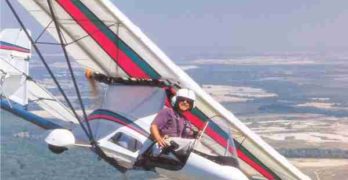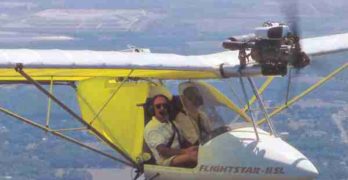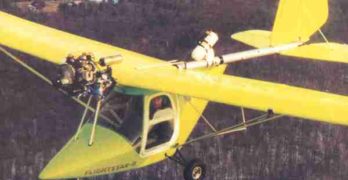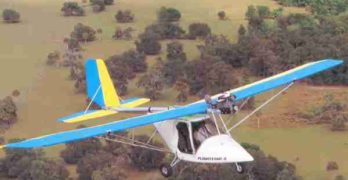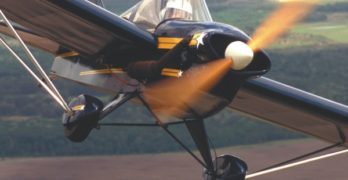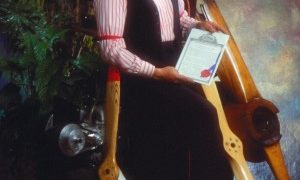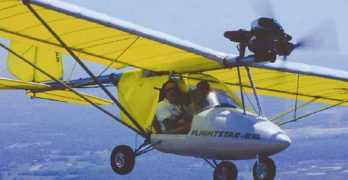ST. PAUL, MINN. — Happy New Year, glider fans. Once again a new year brings wintertime
chills, at least for us northerners. So, this month I have some warm-up ideas
to get you in the mood for a new soaring season.
Mexican Flying Tours are in full swing for HGs and PGs. Cold weather flyers take
note of temperatures in the 80s with plentiful thermals and authentic Mexican food.
One outfit calls the experience a “Mextravaganza.”
Super Fly Paragliding Mexico Tours 2004 treks to the famous Valle de Bravo
site in central Mexico. At it for eight years, Super Fly takes you to fly three sites
in seven days during January and February. PG gurus Jeffrey Farrell and Chris
Santacroce are leading two tours in January and one in early February for pilots
with P2 ratings or better and a minimum of 50 flight hours.
They’ll handle the language, pickup and delivery from Mexico City airport, offer
5-star lodging in “a new, secure, classy, and clean hotel,” local club memberships,
XC retreival in air conditioned vehicles, and in-flight coaching by radio.
Search Results for : flight design ct
Not finding exactly what you expected? Try our advanced search option.
Select a manufacturer to go straight to all our content about that manufacturer.
Select an aircraft model to go straight to all our content about that model.
Product Lines – January 01
ST. PAUL, MINN., — An interesting thing happened last fall. As 2000 came to a close, Italian flex-wing (Laminar) producer, Icaro, reached an accord with Germany’s top rigid wing (ATOS) producer, A.I.R. ••• Web writer, Davis Straub, reported in his Oz Report, "A.I.R. has moved its assembly operation and shipping to Icaro in Italy. Icaro has been a strong partner with A.I.R. from the start, producing parts and making sails, as well as being responsible for a significant portion of the distribution. Now it looks like Icaro is in a stronger position with respect to A.I.R." • Icaro confirmed Straub’s report saying, "In these past years, Icaro played already an important role at A.I.R. with producing the major part of the sails, the A-frames and the keels for the ATOS and, in addition, has sold over 130 of them." Icaro expressed, "Since the ATOS has been performing in such an incredible manner (present World and European Champions fly ATOS), we will not modify it for next year." • Straub, an outspoken supporter and user of rigid wings — such as in his notable record reported here in October — adds his personal feelings, "As a customer I feel more secure in having a larger and more diverse hang gliding company taking on more responsibilities for the ATOS.
Product Lines – January 00
ST. PAUL, MINN., — Welcome to a new era of hang gliding… well, and everything else, I guess. If you’re reading this, the Y2K bug evidently didn’t stop civilization as some feared. At least you got your Hang Gliding magazine. Is something more important than that? ••• As we start a new millennia, it pays to take stock of the state of the art. Topless flexwings are achieving great flights and cost Six Grand. Rigids wings seem to be the new darlings despite breaking the Ten Grand price barrier. We have carbon/kevlar helmets, highly sophisticated electronic navigation and flight performance instruments, and everybody flies with a parachute, sometimes two. Heck, we’ve even got luxury sport utility vehicles to haul it all around. Aren’t we something, cool 21st Century pilots? So I suppose it makes sense that lots of attention seems focused on the harness as we start a new year. It’s the new front line in the relentless drive for more performance.
Quicksilver Manufacturing — GT400
One of the best regarded light aircraft on the market is the GT400 from newly reorganized and revitalized Quicksilver. The longtime manufacturer of ultralights has new ownership and good things are happening. Fortunately, the Southern California leader stuck with their successful models.
According to many who have flown it, the GT400 is one of the best flying single seat aircraft you can buy. To beginners, it is predictable and stable with qualities that allow a new pilot to progress with confidence. To old timers, the GT400 has such refined characteristics that it can please those with many hours logged.
Using a control yoke rather than a joystick, GT400 emulates certified aircraft yet for all its sophistication, the design does not lose any of the fun side that makes ultralights so enjoyable. Handling is smooth but responsive. Performance is substantial but not scary. And its stability profile sets a standard for light aircraft.
Flightstar Inc. — Flightstar II SL Tailback
“New & Improved” boasts the advertising for the Flightstar IISL as it was introduced at the start of the 1999 season. Indeed, the statement proved to be more than a catchy advertising slogan. The already-popular ultralight from the Connecticut company managed to go one better than earlier models.
A series of changes subtly advanced the state of the art for one of America’s best ultralights. A new cabin fairing was cunningly reshaped to combine smoothly with a new, curvier windscreen. The aft-cabin fabric fairing was made leaner and smaller yet more efficient. And a new engine cowling improved cooling for the Rotax 503 engine installation.
The combination of front and rear fairing harmonized to bring smoother touchdowns eliminating the one nagging challenge I’d found in the older IISL. Making consistently smooth landing roundouts is now child’s play. Builders will also appreciate the easier fit of the new fiberglass parts and shipping is more compact (therefore cheaper) than ever due to the change.
Flightstar Inc. — Flightstar II + HKS Engine
Daring to take on deeply entrenched Rotax, Flightstar/H-Power has introduced the first light aviation four-stroke engine to see broad acceptance. Joined with their smoothly contoured Flightstar II, you can have a deluxe ultralight or lightplane that will provide years of flying enjoyment.
While two strokes do the job for most ultralight enthusiasts, the four stroke 700E engine from HKS of Japan offer assurances some pilots demand. With its particular strength of mid-range torque, the HKS engine brings interesting differences. Pull up the nose while revolutions are set in the 4000s and the HKS will haul the Flightstar II aloft with no evidence of prop loading common among two stroke engines.
Flightstar still sells lots of their very popular IISL models, but on this lighter aircraft, they recommend the Rotax 503. However, now that the same company has adapted the stronger HKS engine, sales are soaring for their Flightstar II with its beautifully formed all-fiberglass cockpit enclosure.
Flightstar II
The popular Flightstar is solidly an American aircraft again after an excursion with overseas ownership. Original designer, Tom Peghiny, and his partner, Sparky LaMontagne, are majority owners in the Connecticut-based ultralight manufacturer. They’ve introduced four models to the community: Flightstar Classic (277 engine), Spyder (447-powered single place), Formula (deluxe full enclosure single seater) and Flightstar (top of the line two-place aircraft).
The Flightstar line distinguishes itself by featuring well engineered designs with cleanly executed hardware on a sleek, solid design. As they pass by in an airshow demonstration, viewers are pleased by the quiet performance of the machines. Factory pilots fly their two place model with the lighter 503 engine; it’s more than enough engine though you can add the more powerful 582. They go fast as well as slow and handle well at either end of the envelope. Present models offer flaps to further extend the speed range.
Efficiency is a watchword with the Flightstars.
Proven Design; Ison Aircraft’s Eros
The pretty blue Eros with bright yellow stars on it is no ordinary ultralight. On second thought, “ordinary” and “Eros” aren’t words that go together. Of those aircraft designed by Wayne Ison and his former TEAM team, this model is the hottest of the fleet. I believe I’ve flown all Ison designs that were put into manufacture and Eros is one of my favorites. (In truth, it’s a tossup between the Max-103, Air-Bike, and the Eros.)
The Legend of Davy Lee
For this month’s pilot report, I got the chance to fly a special Eros, a Grand Champion at Sun ‘n Fun ’98 in the Lightplane Class. It belongs to owner/builder/pilot Davy Lee Cooper and it represents my second review of an Eros.
Cooper’s Eros is Rotax 503-powered as was the earlier Eros I flew, but both are derived from the Eros-preceding V-MAX with a Half VW engine. Without a doubt the Rotax 503 is more energetic, yielding better climb rates and somewhat faster speeds.
Chuck’s Patented Reduction Drive?
Chuck’s Patented Reduction Drive?
Back when ultralights were new, most engine/prop combinations were direct drive. General aviation aircraft engines are direct drive. Of course, these run at slower revolutions so the prop speed isn’t excessive. On a high-revving 2-stroke engine, direct-drive props (commonly 36-inch diameters) are spinning so fast the prop tips create a lot of noise.
When I owned and flew a Flight Designs Jet Wing trike back in 1982, that direct-drive Kawasaki 440 engine and prop were so loud my neighbors complained and I had to cease flying except during certain hours.
To the rescue came Chuck Slusarczyk and his invention. The funny thing is, his patent is not for the reduction drive as many think and as this sidebar’s title suggests.
Even before he designed his groundbreaking Hawk, Chuck developed and was the first to use an “ultralight” reduction drive. His early experience was during the days of experimentation of powered hang gliders.
Flightstar II SL
Since Tom Peghiny and partner Spark Lamontagne first lightened the Flightstar and named one model the II SL (for “Sport Light”), they haven’t been able to sit still and simply admire their work. From our first pilot’s report on the SL 3 years ago,1 the two have tweaked and adjusted the model to find even better qualities.
A new front and aft fairing are part of the package, and the latter you might notice rather quickly. Virtually all the rest of the improvements are subtle things. In fact, that word is a hallmark of Flightstar innovation.
No surprise then that the company should adopt “New and Improved” as its new advertising headline to assure you know about the changes.
Better and Better
I’ve followed the Flightstar from its first flight, when it wasn’t even the Flightstar. This design – which once crossed the Atlantic – is from the inventive mind of Swiss national Hans Gygax, and became the rather gaudy 440ST.
- « Previous Page
- 1
- …
- 32
- 33
- 34
- 35
- 36
- …
- 145
- Next Page »


